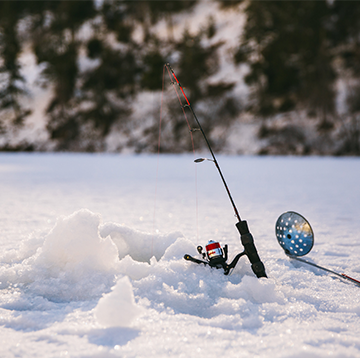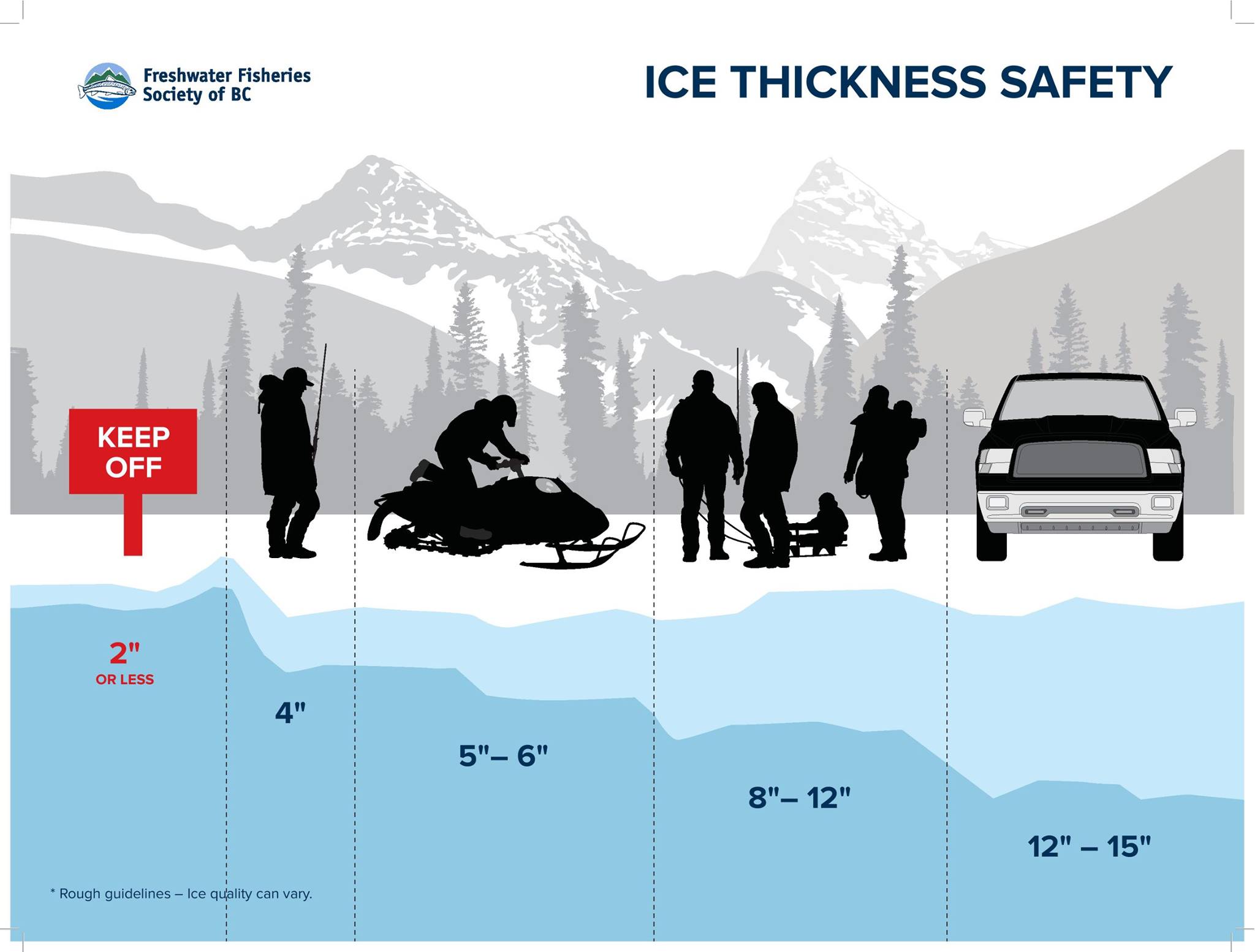Winter is here, and with it – ice-fishing season. Ice-fishing is an inexpensive and unique, family-friendly experience. With some basic gear and knowledge, you can be drilling a hole and dropping a line through the ice in no time. Hot chocolate and roasted wienies over a campfire are the perfect accompaniments to exciting fish-catching action.
The most popular under-ice fish are rainbow and eastern brook trout, along with kokanee. The Freshwater Fisheries Society of BC stocks many of the lakes in the Thompson-Nicola region with these species. While there are hundreds of lakes that can be fished throughout the winter, we have chosen five of our favourites to share with you. As these lakes are located close to major towns or highways, they are relatively easy to access, even during winter.
1. Logan Lake
Located right in the town of the same name, Logan Lake can almost be described as an urban lake. Lying about halfway between Merritt and Kamloops, it is stocked with catchable-sized rainbow trout annually. Current regulations allow anglers to retain two rainbow trout per day. Try using bait like maggots, earthworms, frozen krill, or pieces of cooked shrimp, and add a kernel of canned corn for extra attraction.
To target rainbow trout, a simple set-up is to attach a sliding weight to your mainline above a barrel swivel, followed by a baited hook on a 30-centimetre-long leader. After drilling a hole in the ice with a manual or power auger, drop the weighted line into the hole, and suspend the bait around 60 centimetres off the bottom. When a fish bites, jerk the line upwards to set the hook.
An aerator used on Logan Lake can cause the ice to be thin in places. Before heading onto the lake, make sure you carefully check that the ice is a safe thickness.
Bonus: Tunkwa Lake, located 20 minutes north of Logan Lake, also offers an excellent winter fishery. Anglers can target Pennask-strain rainbow trout, 40,000 of which are stocked into the lake annually.
2. Walloper Lake
If you’re looking for a family- or beginner-friendly lake, travel 40 kilometres south of Kamloops along Highway 5 to Walloper Lake. Although the rainbow trout in this lake tend to be small, they are numerous. Since your children (and you) can be rewarded with many bites, everyone will keep their interest for longer. To help detect the lighter bites of the smaller fish, make sure to use a flexible rod, and attach a fishing float to your line. Try using mealworm or other bait on a smaller-sized #6 hook. Because Walloper Lake is aerated, be on the lookout for thin ice.


3. Monte Lake
Conveniently located near Highway 97, Monte Lake is easily accessible, and has one of the best winter kokanee fisheries in the area. Each year, the Freshwater Fisheries Society of BC stocks Monte Lake with 15,000 of these tasty land-locked sockeye salmon, along with 5,000 rainbow trout. This is a popular lake, so make sure you leave your fishing spot cleaner than you found it. Take your trash with you, and if you can, pick up any other trash that you see in the area.
Kokanee prefer deep lakes, and typically school together. They feed on minute zooplankton higher in the water column. A typical scenario for kokanee fishing would be to find water that is anywhere from 10 to 25 metres deep, and fish suspended baits or jigged lures at depths between five and seven metres. Jigging is the process of slowly raising and lowering your rod to flutter your lure up and down through the water column to attract fish. Adding a small piece of bait to a flashy lure or jig can be an effective way to fish for kokanee.
4. Mamit Lake
Mamit is a large lake located near Highway 97C, south of Logan Lake. Its proximity to the highway and easy access make it another popular location for ice-fishing. Mountain whitefish, rainbow trout, and burbot are some of the species that you can find here; however, current regulations require anglers to release all burbot. For the best chances of success, scout the lake to pinpoint where fish are most likely to be found. Try off points of land, or in bays where the bottom tapers up to the shore evenly. This is important when ice-fishing on any lake, but particularly on large lakes. When you have picked a location, be sure to drill several holes in a line from deep to shallow water to determine where in the water column fish are located. Fish one hole for a while, then move to another, until you find fish.
5. Chicken Ranch Lake
This little-known lake can be found south of Merritt on the Kane Valley Road, which branches off Highway 5A. Each year, 5,000 sterile brook trout are stocked into the lake. “Brookies” provide an excellent winter fishery as they tend to perform better than some other species in lakes with low oxygen levels. When targeting this species, the best fishing is often found in water less than five metres deep; in many situations, fishing in depths of three metres or less can be very effective.


Always check the thickness of the ice before heading out onto a lake. Make sure that the ice is at least 10 centimetres (four inches) thick if you’re fishing alone, and at least 30 centimetres (12 inches) thick before you bring out your family.
Check the freshwater regulations to be sure that there is not an ice-fishing closure or bait ban in place on the water body you want to fish. Remember that all anglers over the age of 16 years require a freshwater fishing licence to go ice-fishing in B.C.
Follow the tips in this blog, keep safety top-of-mind, and you’ll be set to enjoy some fun on the ice this winter.
Author: Staff, Freshwater Fisheries Society of BC
Images: Nick Basok, Brennan Lund, Derek Richardson, Justine Russo, Rodney Hsu.
